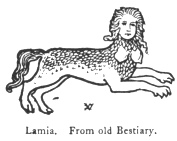
Sacred Texts Legendary Creatures Symbolism Index Previous Next
Buy this Book at Amazon.com


Fictitious and Symbolic Creatures in Art, by John Vinycomb, [1909], at sacred-texts.com
A curious creature of the imagination is the lamia, of which we are told many fictitious stories. It is said
 |
In Dr. Brewer's "Dictionary of Phrase and Fable," Lamia is "a female phantom whose name was used by the Greeks and Romans as a bugbear to children, from the classic fable of a Lybian Queen beloved by Jupiter, but robbed of her children by Juno; and in consequence she vowed vengeance against all children, whom she delighted to entice and murder." They are again described as spectres of Africa, who attracted strangers and then devoured them. In the story of "Machatës and Philemon," a young man is represented
as marrying an Empusa, who sucks his blood at night. Goethe borrowed his ballad of the "Bride of Corinth" from this tale.
Beyond casual mention this mythical creature does not appear in heraldry.